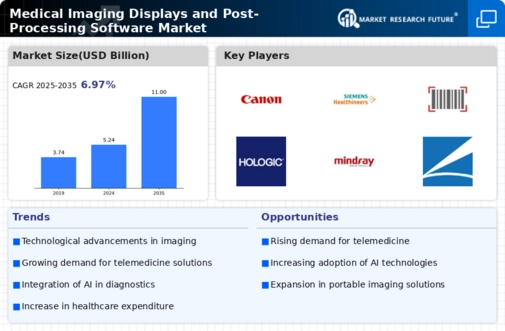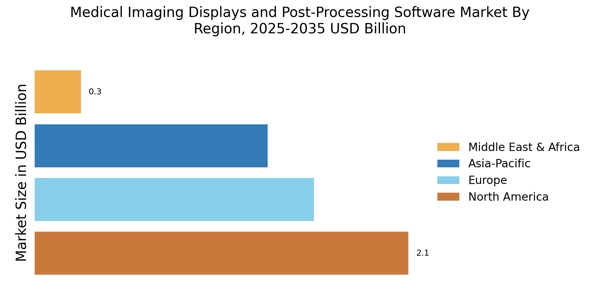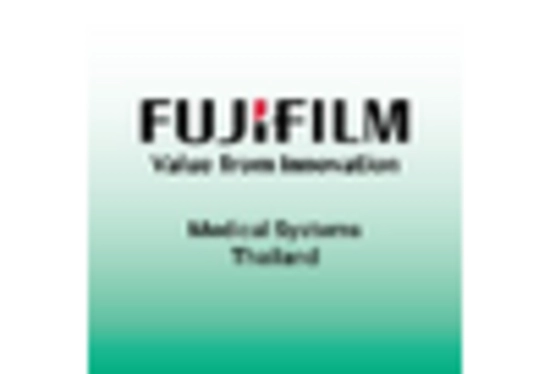The Medical Imaging Displays and Post-Processing Software Market is currently characterized by a dynamic competitive landscape, driven by technological advancements, increasing demand for high-quality imaging, and the growing emphasis on patient-centric healthcare solutions. Major players such as GE Healthcare (US), Siemens Healthineers (DE), and Philips Healthcare (NL) are at the forefront, each adopting distinct strategies to enhance their market positioning. GE Healthcare (US) focuses on innovation through the development of advanced imaging technologies, while Siemens Healthineers (DE) emphasizes strategic partnerships to expand its product offerings and market reach. Philips Healthcare (NL) is actively pursuing digital transformation initiatives, integrating AI and machine learning into its imaging solutions, thereby enhancing diagnostic accuracy and operational efficiency. Collectively, these strategies contribute to a competitive environment that is increasingly centered around technological innovation and collaborative growth.
In terms of business tactics, companies are localizing manufacturing and optimizing supply chains to enhance operational efficiency and reduce costs. The market appears moderately fragmented, with a mix of established players and emerging companies vying for market share. The collective influence of key players is significant, as they not only drive technological advancements but also set industry standards that smaller firms often follow. This competitive structure fosters an environment where innovation is paramount, and companies must continuously adapt to maintain their competitive edge.
In August 2025, Siemens Healthineers (DE) announced a strategic partnership with a leading AI firm to enhance its imaging software capabilities. This collaboration aims to integrate advanced AI algorithms into Siemens' imaging systems, potentially revolutionizing diagnostic processes and improving patient outcomes. The strategic importance of this move lies in its potential to position Siemens as a leader in AI-driven imaging solutions, thereby attracting healthcare providers seeking cutting-edge technology.
In September 2025, Philips Healthcare (NL) launched a new line of imaging displays designed specifically for telemedicine applications. This initiative reflects a growing trend towards remote healthcare services, allowing healthcare professionals to provide high-quality diagnostics from various locations. The strategic significance of this launch is underscored by the increasing demand for telehealth solutions, positioning Philips favorably in a rapidly evolving market.
In July 2025, GE Healthcare (US) expanded its manufacturing capabilities in Asia to meet the rising demand for medical imaging products in the region. This expansion not only enhances GE's supply chain resilience but also allows for quicker response times to market needs. The strategic importance of this move is evident in its potential to strengthen GE's market presence in Asia, a region that is witnessing significant growth in healthcare investments.
As of October 2025, the competitive trends in the Medical Imaging Displays and Post-Processing Software Market are increasingly defined by digitalization, sustainability, and the integration of artificial intelligence. Strategic alliances are becoming more prevalent, as companies recognize the value of collaboration in driving innovation and enhancing product offerings. Looking ahead, competitive differentiation is likely to evolve from traditional price-based competition to a focus on technological innovation, reliability in supply chains, and the ability to deliver superior patient outcomes. This shift underscores the importance of adaptability and forward-thinking strategies in navigating the complexities of the healthcare landscape.


















Leave a Comment